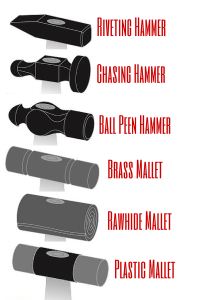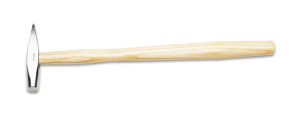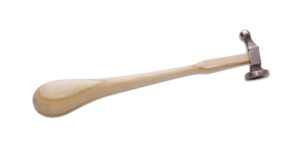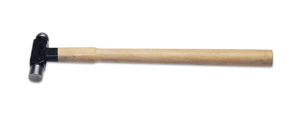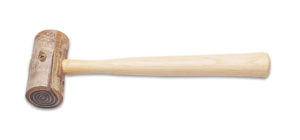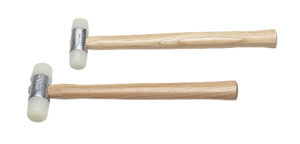One of the tools a silversmith reaches for most often is their hammer. We all have our favourite one…or 3, but if you are just starting to build your tool collection, picking the right hammer for the job can be a daunting task. Below I will break down the 6 most common types of hammers used in silversmithing.
Riveting Hammer
The wedge shaped end of this hammer is perfect for spreading the heads of rivets, while the flat end, which can have either a round or square cross section, is used for flattening out and refining rivet heads. The wedge end is also handy for creating interesting textures on metal.
Chasing Hammer
The large face of this hammer can be used to strike the end of chasing tools and punches, but can also be used for direct contact with metal. Make sure, however, that if you’re going to use it on the metal in your piece, that the head is smooth and not market by hitting other tools. We recommend using a Brass Hammer for hitting chasing tools, punches, or any steel tool, because hitting steel with steel can shatter a tool! Chasing hammers can have either flat or a slightly rounded surface, which can act as a planishing hammer used for stretching and changing the shape of metal. Chasing hammers can easily be identified by their unique handles: bulbous at one end and thin where the head is attached. This style of handle increases hammer control and reduces hand fatigue.
Ball Peen Hammer
Probably the most recognizable style of hammer, the ball peen hammer comes in countless shapes, sizes and weights. This is a great general purpose hammer with one flat face and one rounded face. It can be used for light forging, striking steel tools, spreading rivet heads, and creating that lovely hammer texture. The size of the rounded face along with the weight of the hammer and the force of each strike will determine the size of each divot in your texture.
Brass Hammer
Brass mallets are used for striking steel tools. When used with stamping tools, a brass mallet prevents unwanted movement because it has less reverberation than steel hammers. A brass mallet should be the only hammer you use on tools like a disk cutter because striking steel against steel with great force can actually shatter one of the tools.
Rawhide Mallet
Rawhide mallets are much softer than steel or brass hammers and therefore will not mar or mark the surface of your metal. Ideal for flattening out sheet or wire as well as shaping rings and bangles on a mandrel, the rawhide head is extremely durable. It is made of leather that has been rolled into a cylinder shape and impregnated with shellac. This hammer is available in a wide variety of face diameters and sizes.
Plastic Mallet
Plastic hammers are similar to rawhide mallets in that they will not mar or mark the surface of your metal. They come is a wide variety of shapes, sizes and styles. The plastic material is typically made from high density, non-porous nylon.
There is no universal hammer that will do it all, so we often find ourselves with quite the selection of hammers as silversmiths.
Check out our Post about Texturing with Hammers HERE
We Sell HAMMERS & MALLETS HERE

